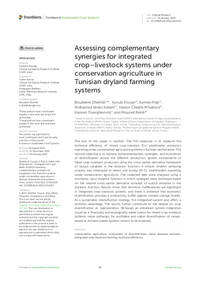Assessing complementary synergies for integrated crop–livestock systems under conservation agriculture in Tunisian dryland farming systems

Authors:
The aim of this paper is twofold. The first objective is to measure the technical efficiency of mixed crop-livestock (CL) smallholder producers operating under conservation agriculture systems in Tunisian rainfed areas. The second objective is to explore complementarities, synergies, and economies of diversification across the different production system components of these crop-livestock producers using the cross-partial derivative framework of output variables in the distance function. A simple random sampling process was employed to select and survey 59 CL smallholders operating under conservation agriculture. The collected data were analyzed using a stochastic input distance function in which synergies were estimated based on the second cross-partial derivative concept of output variables in the distance function. Results show that technical inefficiencies are significant in integrated crop-livestock systems, and there is evidence that economic diversification provides a productivity buffer against climate change threats. As a sustainable intensification strategy, this integrated system also offers a potential advantage. The results further contribute to the debate on crop diversification vs. specialization. Although an enhanced system integration could be a financially and ecologically viable option for mixed crop-livestock systems, more pathways for profitable and viable diversification of cereal-based or orchard-based systems remain to be explored.
